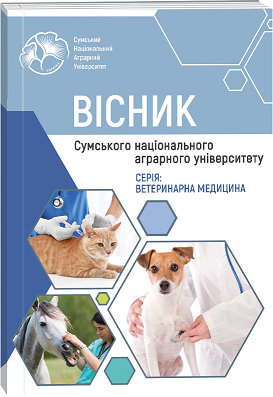Розробка ПЛР для одночасного виявлення Pasteurella multocida та Haemophilus parasuis
Анотація
Pasteurella multocida та Haemophilus parasuis, є основними збудниками респіраторних захворювань свиней на колективних свинарських фермах усіх країн з розвиненим свинарством. Збудники мають значний вплив на дихальні шляхи свиней та серйозно перешкоджають росту і розвитку, а відповідно, знижують продуктивність. Тому метод швидкого виявлення цих мікроорганізмів є запорукою успішної профілактики та контролю інфекцій.
Традиційні методи лабораторних досліджень для підтвердження попереднього діагнозу, поставленого на підставі аналізу даних анамнезу, клінічних симптомів, патологічних змін та епідеміологічних характеристик захворювання, включають бактеріологічні дослідження Pasteurella multocida та Haemophilus parasuis, культуральну, біохімічну та імунологічну ідентифікацію. Ці методи трудомісткі й не можуть задовільнити потреби у швидкій діагностиці, що ускладнює можливості профілактики та контролю хвороб тварин. Pasteurella multocida та Haemophilus parasuis обидві є збудниками синдрому респіраторних захворювань свиней (PRDC), і часто виступають у вигляді асоціаційованої інфекції, тому необхідно встановити точний і швидкий метод ідентифікації обох загальних збудників респіраторних хвороб у свиней. У цій роботі Pasteurella multocida та Haemophilus parasuis використовувались як об’єкти дослідження для розробки подвійного методу ПЛР-детекції.
Основний зміст досліджень полягає в наступному: було досліджено компоненти та реагенти та відпрацьовано покроковий порядок постановки подвійної ПЛР для одночасного виявлення Pasteurella multocida та Haemophilus parasuis, використовуючи специфічні для Pasteurella multocida and Haemophilus parasuis праймери, а також, регулюючи концентрацію праймерів та температуру відпалу.
Метод швидкого виявлення Pasteurella multocida та Haemophilus parasuis, описаний у цьому дослідженні, має високу специфічність та чутливість і може реалізувати швидку та точну ідентифікацію патогенних бактерій за відносно короткий проміжок часу, забезпечуючи нові технічні засоби для швидкого виявлення Pasteurella multocida та Haemophilus parasuis у лабораторії.
Посилання
Cardoso-Toset F, Gómez-Laguna J, Callejo M, et al. (2013). Septicaemic pasteurellosis in free-range pigs associated with an unusual biovar 13 of Pasteurella multocida. Vet Microbioogyl, 167(3-4): 690-694.
Gao PC, Chu YF, Zhao P, et al. (2008). Screening of culture conditions for Haemophilus parasuis and its pathogenicity test to guinea pigs. Advances in Veterinary Medicine, (10):10-13.
Harper M, Boyce J D. (2017). The Myriad Properties of Pasteurella multocida Lipopolysaccharide. Toxins, 21, 9(8): 254-275.
Li J Y, Zhang J M, Xu C G, et al. (2010). Research progress on main virulence factors and pathogenic mechanism of Haemophilus parasuis.China Animal Husbandry and Veterinary Medicine, 37 (12) : 173-176.
Li J, Xie Y Z, Xuan Xiongbiao, et al. (2011). Real time fluorescence PCR of Haemophilus parasuis Establishment and application of rapid detection method. Anhui Agricultural Sciences, 39(6) : 3607-3609.
Liang Q, Yang B, Yong S L, et al. (2018). PCR method for detection of Haemophilus parasuis. Modern Animal Husbandry and Veterinary Medicine, 358 (09) : 10-13. (in Chinese)
Lin, Wei-Hao, Shih, Hsing-Chun, Lin, Chuen-Fu, Yang, Cheng-Yao, Lin, Chao-Nan & Chiou, Ming-Tang. (2019). Genotypic analyses and virulence characterization of Glaesserella parasuis isolates from Taiwan. PeerJ. 7. e6960. https://doi.org/10.7717/peerj.6960.
Ma, Lina, Wang, Liyan, Chu, Yuefeng, Li, Xuerui, Cui, Yujun, Chen, Shengli, Zhou, Jianhua, Li, Chunling, Lu, Zhongxin, Liu, Jixing & Liu, Yongsheng. (2016). Characterization of Chinese Haemophilus parasuis Isolates by Traditional Serotyping and Molecular Serotyping Methods. PLoS ONE. 11. https://doi.org/10.1371/journal.pone.0168903.
Malorny B,Tassios P T,Radstrom P,et al. (2003). Standardization of diagnostic PCR for the detection of foodborne pathogens.Int J Food Microbiol,83( 1) : 39-48.
Moriy,Nagamine K,Tomita N,et al.(2010). Development of multiplex - PCR for identification of Pasteurella multocida,Haemophilus parasuis and Actinbacillus pleuropneumoniae. Anim Feed Sci Tech, ( Z2) : 25-27.
Nedbalcova, Katerina, Satran, P., Jaglic, Zoran, Ondriasova, R. & Kucerova, Z. (2018). Haemophilus parasuis and Glässer’s disease in pigs: a review. Veterinární Medicína. 51. 168-179. https://doi.org/10.17221/5537-VETMED.
Ni, Hong-Bo, Gong, Qing-Long, Zhao, Quan, Li, Xiao-Yue, Zhang, Xiao-Xuan. (2020). Prevalence of Haemophilus parasuis“Glaesserella parasuis” in pigs in China: A systematic review and meta-analysis. Preventive Veterinary Medicine. 182. 105083. https://doi.org/10.1016/j.prevetmed.2020.105083.
Rebenko H. I. (2014). Etiolohiia ta epizootolohiia infektsiinykh khvorob respiratornoho traktu svynei (ohliad literatury) [Etiology and epizootology of infectious diseases of the respiratory tract of pigs (literature review)] Visnyk SNAU seriia «Vet med». [Bulletin of the SNAU series "Vet Med"], № 1 (34), 114-121.
Si Z S, Wang G Y. (2011). Research progress of hemophilus parasuis . China Animal Husbandry and Veterinary Medicine, 38 (06): 179-182. (in Chinese with English abstract)
Starkey, S.R. & Donnelly, T.M.. (2012). Pasteurella multocida. Clinical Veterinary Advisor: Birds and Exotic Pets. 717-719. https://doi.org/10.1016/B978-1-4160-3969-3.00418-2.
Xue G C, Ren T. (2009). Epidemiology and pathogenic factors of Haemophilus parasuis. Chinese Journal of Animal Husbandry and Veterinary Medicine, 36 (05): 168-171. (in Chinese)
Zhang Bin, Tang Chen, Liao Ming, et al. (2014). Update on the pathogenesis of Haemophilus parasuis infection and virulence factors. Vet Microbiology, 168(1): 1-7.
Zhang Y, Li J, Li W J, et al. (2017). PCR method for detection of Bacillus multicidal bars Chinese Journal of Veterinary Medicine, 51 (05) : 16-21. (in Chinese with English abstract)
Zhang Yuan, Wei Caiwen, Li Jian, et al. (2014). Application of multiplex PCR in capsular sequencing of Pasteurella multocida. Chinese Journal of Veterinary Science, 44 (12): 1286-1291.

Ця робота ліцензується відповідно до Creative Commons Attribution 4.0 International License.

 ISSN
ISSN  ISSN
ISSN 



